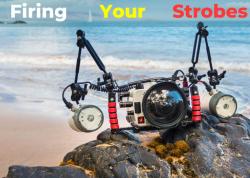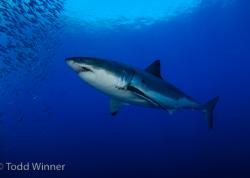Ultimate Guide to Canon 7D Underwater Settings
I definitely feel that the best way to learn underwater photography and your camera is to understand what the controls do and how they affect each other. But, I also know what it is like to just want to get in the water with your new camera and not read the manual. This is a “quick start guide” to some the optimal underwater photography settings for the Canon 7D. You also read about the Canon 7D underwater video settings.

Canon 7D, Taken in La Paz, Baja. Tokina 10-17mm lens @10mm. F7, 1/160th, ISO 160
Quick start for first-time Canon 7D users
The first thing I would do is go into the menu settings, settings some values and disabling a few functions.
First Menu Settings:
• Quality: Set to RAW
• Peripheral Illumination Correction: Disable
Second Menu Settings:
• Auto Lighting Optimizer: Disable
• Color Space: Adobe RGB
Custom Menu Settings:
• C.FnII: 3 Highlight Tone Priority: Disable
• C.FnIII: 11 AF-assist beam firing: Disable
Most of these settings have no effect on your RAW image, especially if you are using a RAW converter from someone other than Canon. However, they can effect how fast your camera processes the image and the JPEG image you see on your camera's LCD screen. I disable the AF-assist beam because my camera is inside a housing it's not doing anything except possibly shining into my port, and causing problems.
Setting the Canon 7D camera controls
Next, I would set my camera controls. The easiest way to set most of these on the Canon 7D, is to hit the Info button 3 times. This will bring up an information screen with all the settings.
You can use the “Q” button to highlight the controls. Then use the joystick to navigate to other controls and use one of the dials can change the settings.

Hunting cormorants, Taken in La Paz, Baja. Canon 7D, Tokina 10-17mm lens @17mm. F9, 1/200th, ISO 200
Canon 7D Camera and info screen settings
• Camera Mode: I prefer to use manual mode. My second choice would be AV and I would only be using TV mode if I were also shooting TTL strobes.
• Shutter Speed: A good place to start for both macro and wide-angle is around 1/125th sec. You can usually just leave this alone for macro, but you will need to adjust for ambient light with wide-angle.
• F-Stop: For macro, start with f11 or f16 and for wide-angle, I typically start out at f5.6. Again for macro, you can usually just leave these alone and adjust your exposure through strobe power and distance changes and wide-angle you will need to adjust for ambient light.
• ISO: There have been a lot of tests run on the Canon sensors and almost everybody agrees, ISO 160 is the cleanest setting for the Canon sensors. I feel this is a good place to start.
• Exposure Compensation: If using AV or TV mode, I would probably set exposure compensation to somewhere around -1. But, I do suggest and prefer shooting in manual mode in which case there is no need to adjust exposure compensation.
• Flash Exposure Compensation: This control does not work with most strobes unless you are using fiber optic sync cables, in which case you can adjust up or down to suit your taste.
• Auto Focus Point: My rule of thumb is to use the widest auto focus setting that works for the job. If I am not getting the results that I want, I move down to a smaller setting, which often ends up being all the way down to single point auto-focus.
• Picture style: Set to neutral
• White Balance: The auto white balance on the 7D works exceptionally well and I use this most of the time for shooting stills. But, often I use the Kelvin settings for wide-angle and video. I simply dial in a Kelvin setting that looks good to my eye on the back of the LCD screen, e.g. 5000K.
• Metering Mode: I prefer to use spot metering in manual mode so I can select a point to meter off of, and be precise. Note that in manual mode, the metering mode doesn't affect your shots, in simply gives you information.
If you are shooting in AV or TV mode, the metering mode gives your camera information it uses to set the exposure, and I would suggest evaluated metering.
• Auto-lighting optimizer: we disabled this in the menu.
• RAW/JPEG settings: set to RAW.
• Focusing Mode: You have 3 choices. I like One Shot AF, and I use this for macro shooting and “still” wide-angle shots like reef scenes. In this mode I can focus on a select spot and then recompose while holding the shutter half way or using the back focus button.
However, for fast-moving subjects or behavior shots, you can use AI Servo mode, because in this mode the constantly tries to track your moving target, and the shot will always be taken the instant you press the shutter.
• Drive speed: Most of the time you should use single-shot, but for action you will want low-speed continuous (3 fps) or high-speed (7 or 8 fps) continuous depending on your strobe recycle ability. Ikelite 160 and 161 strobes can keep up with high-speed continuous pretty good at most power settings.

Canon 7D, Taken in La Paz, Baja. Canon 60mm lens. F20, 1/125th, ISO 200
Canon 7D underwater settings for macro and wide-angle
As you get experienced, you will find yourself changing all your settings depending on the shot. However, if you just starting out, these settings should work reasonable well:
Macro Settings:
F16, 1/250th, ISO 160. Adjust strobe power as needed to control exposure of the subject.
Wide angle, Cold water:
F5.6, 1/125th, ISO 160. Adjust shutter speed as needed to control background (ambient light) exposure.
Wide angle, Tropical water:
F8, 1/125th, ISO 160. Adjust shutter speed as needed to control background (ambient light) exposure.
Further Reading:
Shooter's Toolbox Vol 1, Ambient Light by Todd Winner
Guide to diving La Paz, Sea of Cortez
Nikon D7000 / D300 / D90 underwater settings
Canon 5D Mark III Review
RECOMMENDED ARTICLES
SUPPORT THE UNDERWATER PHOTOGRAPHY GUIDE:
The Best Service & Prices on u/w Photo Gear
 Visit Bluewater Photo & Video for all your underwater photography and video gear. Click, or call the team at (310) 633-5052 for expert advice!
Visit Bluewater Photo & Video for all your underwater photography and video gear. Click, or call the team at (310) 633-5052 for expert advice!
The Best Pricing, Service & Expert Advice to Book your Dive Trips
 Bluewater Travel is your full-service scuba travel agency. Let our expert advisers plan and book your next dive vacation. Run by divers, for divers.
Bluewater Travel is your full-service scuba travel agency. Let our expert advisers plan and book your next dive vacation. Run by divers, for divers.
































